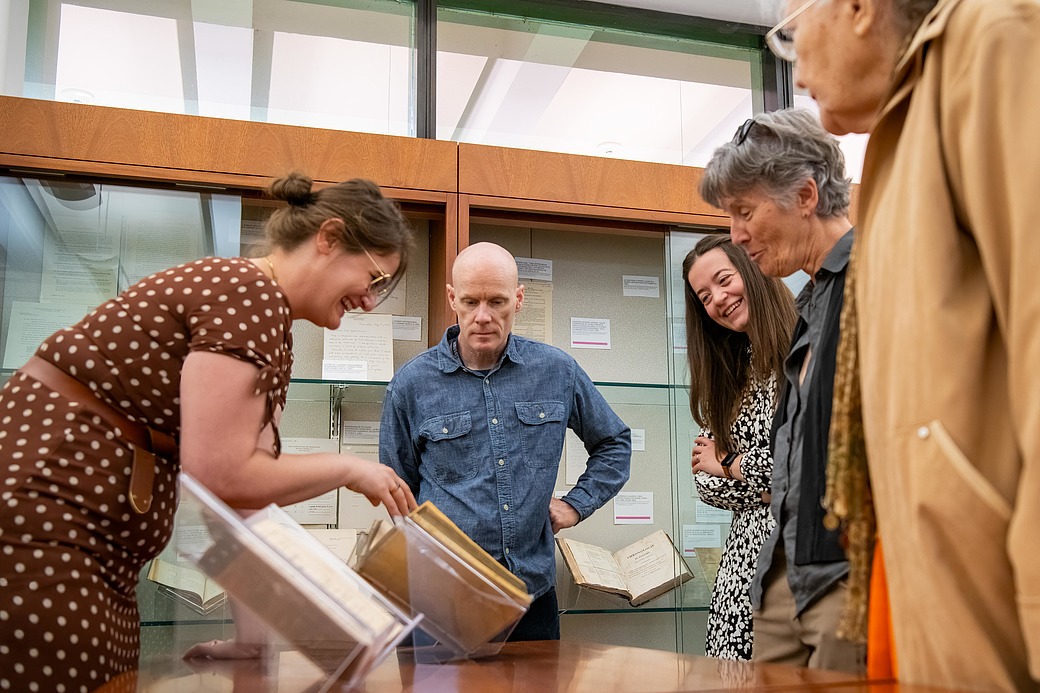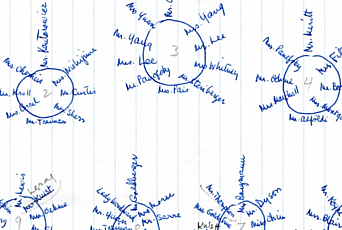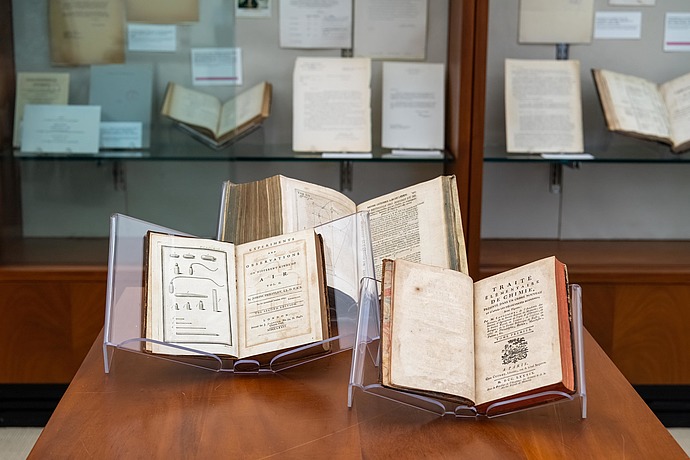
Snapshots of Scientific Discovery Revealed through IAS Rare Book Collection
This summer, a new exhibition, titled “Interpretation and Organization: Critical Approaches to the IAS Rare Book Collection,” opened at the Institute’s Shelby White and Leon Levy Archives Center. The exhibition showcases historical works of scholarly literature from the Institute’s rare book collection, which began in 1951 with a gift from IAS Trustee (1940–70) and Trustee Emeritus (1970–79) Lessing J. Rosenwald. Drawing on documents from the Archives Center, the exhibition also highlights the more contemporary scholarship and debates that these works have inspired. Curated by the Archives Center and Research and Curation Specialist Lorenza Pescia De Lellis, the display celebrates how—from the Institute’s founding in 1930 to the present day—IAS scholars have brought that which is known into conversation with that which is newly discovered.
The scholarly disciplines and historical eras covered by the exhibition are vast: from one of the earliest foundations of mathematical logic found in the works of Gottfried Wilhelm Leibniz to the twentieth century logistics work of Alfred Tarski, Member (1942) in the School of Mathematics, and Rudolf Carnap, Member (1952–54) in the School. Pairings of scholarly literature and archival documents demonstrate how old ideas and understandings have been reinterpreted and reorganized in a contemporary context by scholars as they work to better understand the natural world and confront new challenges as they arise.
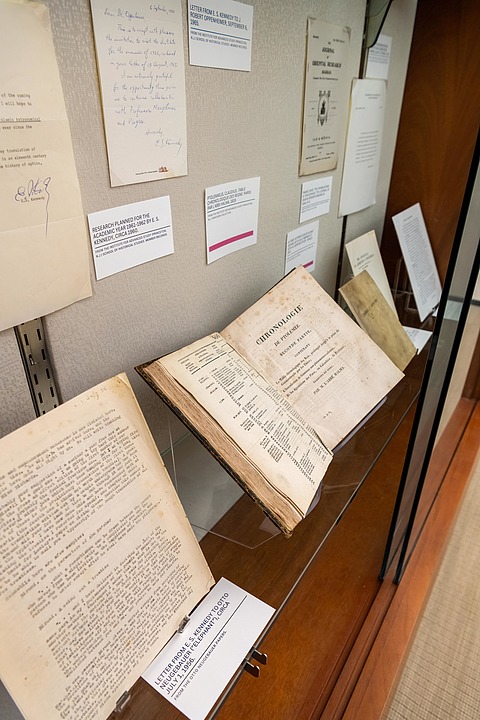
In the exhibition, an Italian translation of the works of Al-Kindī—widely considered the father of Arabic philosophy—dating from 1507, is presented in conversation with the works of Edward Stewart Kennedy, who served as a frequent Member in both the Schools of Historical Studies and Mathematics during his time at IAS. In his papers, Kennedy re-examined and translated ancient Arabic astrology. Together, these documents tell a story of the key role astrology has played in the development of astronomy, the interdisciplinary research that brings ancient scholarship into contemporary contexts, and the transcendence of borders between “Eastern” and “Western” philosophical and scientific traditions.
Kennedy and his collaborators had a global impact. A letter highlighted in the exhibition reveals that Kennedy helped to bring fellow Brown University historian of mathematics David Pingree to IAS. Pingree, who served as a Member in the School of Historical Studies (1968–69, 1978–79), had a keen interest in using scientific texts from later periods to illuminate and reconstruct earlier scientific knowledge. His approach involved examining Arabic treatises to shed light on early Greek astronomical and astrological texts, consulting Sanskrit texts in an effort to explain aspects of Arabic astronomy, and tracing the influence of Indian astronomy as it appeared in medieval European sources.
IAS scholars engaging in cross-cultural and cross-disciplinary scholarship can also be seen in the display of an early eighteenth-century copy of Data from Euclidis megarensis philosophi acutissimi mathematicorumque omnium…, an addendum to Euclid’s more frequently studied Elements. Displayed alongside this rare piece of literature are off-prints and notes from two Japanese scholars who served as Members in the School of Historical Studies, Shuntarō Itō (1971–72) and Natsuhiko Yoshida (1976–77). Both devoted their time at the Institute to the study of the history and philosophy of science, and the translation of older works in the field. Itō spent his tenure at the Institute examining Euclid’s Data and its various translations to better understand how knowledge of Euclid’s work came to be and how it continued to be re-interpreted. Likewise, Yoshida devoted his IAS Membership to the philosophy of science and logic, also translating various philosophical scholars’ work into Japanese for dissemination in his home country’s scholarship. Works from both Itō and Yoshida can be found in the Japanese Studies in the Philosophy of Science, a scholarly journal which aimed to popularize the work of philosophers and historians of science within the country and to demonstrate the country’s engagement with these fields of study.
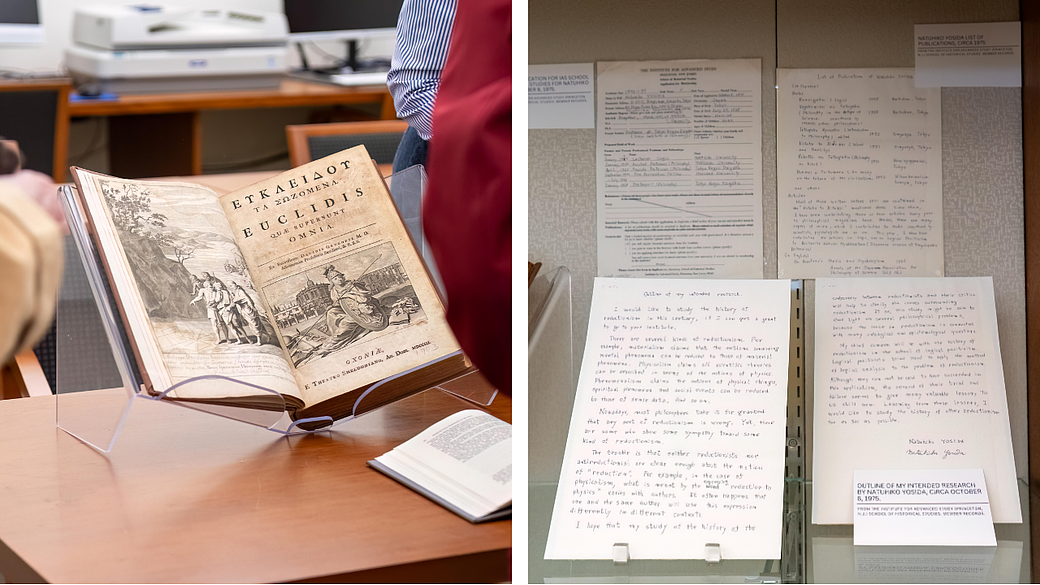
Another example of the interplay between old and new scholarship can be seen in the display of works by philosopher Karl Popper and historian of science Thomas Kuhn, who served as a Member (1972, 1973–79) in both the School of Historical Studies and School of Social Science. Both scholars considered what might constitute a paradigm shift in the history of knowledge, or what made a piece of scientific work remarkable, as opposed to what Kuhn described as “normal” science. One such paradigm shift is the discovery of oxygen, which both Popper and Kuhn cited as a remarkable moment in the history of science; however, who should be credited for the remarkable breakthrough in the late eighteenth century—Joseph Priestley or Antoine Lavoisier—is an ongoing debate in the field of chemistry and the natural sciences more widely.
Visitors to the exhibition have the chance to view Priestley’s Experiments and Observations on Different Kinds of Air, in which the experiment that he used to discover oxygen, or “dephlogisticated air” as he called it, was elucidated. It is displayed side-by-side with Traité Élémentaire de Chimie, one of the earliest textbooks in chemistry, written by Lavoisier and his wife, Marie-Anne. The textbook describes the similar experiments that led to Lavoisier’s discovery of oxygen, in which he heated mercuric oxide and other substances, ultimately synthesizing water from oxygen and hydrogen gases. These volumes are displayed surrounded by archival pieces detailing the works of Popper and Kuhn, whose work is often compared and re-interpreted in the fields of the philosophy of the natural sciences and knowledge. Their research has inspired similar debates to those surrounding the discovery of oxygen by either Priestley or Lavoisier.
Cross-disciplinary research is a hallmark of another scholar whose research is on display, Evelyn Fox Keller, Member (1987–88) in the School of Social Science. In her 1992 book, Secrets of Life, Secrets of Death: Essays on Language, Gender and Science, Fox Keller re-examined and critically analyzed the role that gender has played in the formation of science as a discipline, and the role it continues to have within academia and its institutions. Beside Fox Keller’s research, Robert Boyle’s A Free Inquiry into the Vulgarly Received Notion of Nature is displayed. Boyle was a landmark seventeenth century scientist who, in this work, described his conception of the philosophical basis of the natural world and how one should approach it. In this book, Boyle also laid the groundwork for many of the philosophical beliefs and structures within the study of the natural sciences, and many of the prejudices that are present within the field. Through her work, Fox Keller brings Boyle’s classical scholarship and its shortcomings into the contemporary era in order to better understand and confront the challenges of the past, and discuss the ways in which scholarship can move into the current day.
The exhibition underscores the Institute's role as an intellectual hub where pioneers in varied fields engage in dialogue between the canonical and the newly uncovered. It emphasizes how each scholar and their discoveries, both at the Institute and beyond its grounds, play a significant role in the development and history of their respective fields. Through their work, today’s IAS scholars carry on this tradition of research in the sciences and humanities, which in turn will prompt even further investigation and revolutionary discovery in the future.
“Interpretation and Organization: Critical Approaches to the IAS Rare Book Collection” is on display in the Shelby White and Leon Levy Archives Center until late September 2024. The exhibition is open to all members of the Institute community. Members of the public are also welcome. Please contact the Shelby White and Leon Levy Archives Center to arrange a visit.
